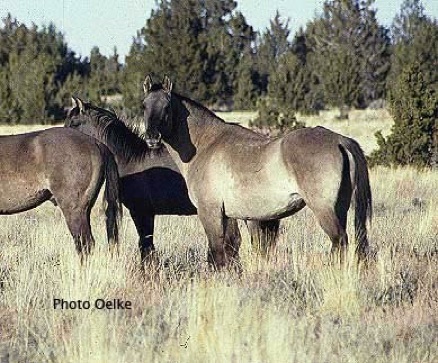DUN FACTOR COLOR AND WHITE MARKINGS
In breeding Spanish mustangs, are the dun factor colors to be preferred, because that was the color of the Iberian wild horse? And should one discriminate against white markings?
There is a general tendency among mustang owners to not think through completely what they are trying to achieve. Mustangs are feral horses – domestic horses that reverted to a wild state. They aren’t wild horses in the zoological sense. As soon as a mustang has been captured and tamed, or if he was even born in captivity, he really ceases to be a mustang, but is again a domestic horse. The wild mustang herds are populations of feral horses. You must realize: the ones captured from these wild herds and kept in captivity thus became domestic horses again.
Wild Kiger mustang stallion of very good Sorraia type
With mustangs, be it in managing the wild herds or breeding them in captivity, one can go different ways. Whatever one decides to do is legitimate: excluding any colors but grulla or dun, or allowing all colors, discriminating against white markings, not to discriminate against white markings, or even encouraging white markings – whatever one finds desirable is legitimate. In regard to the mustang registries, they are membership-oriented, membership-driven organizations, and whatever the majority of their members desire should be their standard. It may not be the individual breeder’s goal, but is the official standard of that registry.
As for genetics, there is no known link between the dun factor and white markings, or white markings and type, or any color and type. White markings occur on all basic colors, including grulla and dun, and are inherited independantly. White markings can occur on horses of ideal type as well as on those of inferior type. Somebody who doesn't want white markings occasionally might have to fight an internal battle over a horse that embodies the perceived ideal type, but happens to have white markings. Or the opposite can be the case.
However, it is quite a different issue for those interested in preserving the Sorraia-type mustang, because in that case, we are talking about an indigenous, primitive Iberian horse. In this case things aren't any longer a matter of taste, or preference; instead, we have a standard to go by that was set by Mother Nature, not by Man. If we want to go that route, we have to stick with regular grulla, or dun, we have got to discriminate against white, and we even don’t have room for conformation preferences.
The fact that even among Portuguese Sorraias one can find an occasional white marking is not contradictory. Nobody claims the Sorraias to be entirely pure anymore. White markings in a Sorraia most likely reflect some outside blood that cropped out, but can also easily be an effect of the extreme inbreeding these horses have suffered. At least 95 % of the Sorraia population is without white. A Sorraia with a white marking is an exception, not a typical example, and certainly not a standard to go by.
White markings occasionally occur even in wild species, as well as albinism, and melanism. There have been spotted deer, white buffalo, white elephants, black leopards, etc. If one wants to preserve a species, one wouldn't want to select odd-colored ones. One tries to preserve what one knows is typical.
White markings usually occur as a by-product of domestication and inbreeding, the latter often being linked to domestication. The extreme inbreeding alone would explain an occasional white marking among Sorraias.

